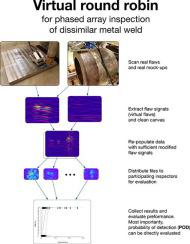Nuclear Engineering and Design ( IF 1.9 ) Pub Date : 2021-05-26 , DOI: 10.1016/j.nucengdes.2021.111297 Iikka Virkkunen , Tuomas Koskinen , Oskari Jessen-Juhler

|
Round robin exercises have traditionally been difficult to arrange in the field of non-destructive testing (NDT). To create a representative round robin exercise, representative mock-ups with representative flaws are needed. The mock-ups are costly and transporting them around the world to facilitate testing by numerous laboratories is difficult. The few round robins that have been completed have often contributed significantly to our understanding on the capability of the used NDT methods and procedures.
Recently, the increased use of automated inspections together with the development of virtual flaws (independently by Trueflaw and EPRI) has enabled a new type of round robin, where instead of moving samples around the world, the round robin is focused on the data analysis and only pre-acquired data files are distributed. This makes conducting a round robin much more cost-effective both in terms of arrangement and in terms of inspection effort from the participating companies. In addition, the virtual flaw technology allows unprecedented number and variety of flaws to be included. With high number of flaws included, the results present statistically meaningful sample and can be further analyzed to estimate the probability of detection (POD) with standard statistical tools. In connection with the international project “PIONIC”, such a virtual round robin was arranged for the first time.
The exercise showed, that virtual flaws and virtual round robins can be used to extract important information about NDT reliability and performance. Also, some points of development were identified for further studies: the sizing and detection files should be better optimized for their respective uses and the data could be further obfuscated to avoid any possibility of inspectors learning to recognize repeating signal patterns.
12 inspectors submitted results to the virtual round robin. The results showed a90/95 ranging from 1.2 to 7.0 mm – a significant variation in performance. The difference was mainly attributed to different inspection strategies. In addition, an unexplained tendency to miss big cracks was noted on some result sets. One of the data files did not contain any flaws. None of the inspectors correctly identified the file as flawless.
中文翻译:

虚拟循环-研究NDT可靠性的新机会
传统上,循环练习很难在无损检测(NDT)领域进行。为了创建具有代表性的循环运动,需要具有代表性缺陷的代表性模型。样机很昂贵,要在众多实验室中进行测试很困难,因此很难将它们运送到世界各地。已经完成的几轮知更鸟常常为我们对所使用的无损检测方法和程序的能力做出了重要贡献。
最近,越来越多地使用自动检查以及虚拟缺陷的发展(由Trueflaw和EPRI独立进行),实现了一种新型的轮询,该轮询不仅用于在世界范围内移动样本,而且专注于数据分析和处理。仅分发预先获取的数据文件。这使得在安排和参与公司的检查工作方面,进行循环赛更具成本效益。另外,虚拟缺陷技术允许包含前所未有的数量和种类的缺陷。由于包含大量缺陷,结果呈现出具有统计意义的样本,并且可以使用标准统计工具进行进一步分析,以估计检测的可能性(POD)。关于国际项目“ PIONIC”,
演习表明,虚拟缺陷和虚拟轮询可用于提取有关NDT可靠性和性能的重要信息。此外,确定了一些发展点,以供进一步研究:调整大小和检测文件应针对其各自用途进行更好的优化,并且可以进一步混淆数据以避免检查员学会识别重复信号模式的任何可能性。
12名检查员将结果提交给了虚拟轮询。结果显示90/95的范围是1.2到7.0毫米–性能上的显着差异。差异主要归因于不同的检查策略。此外,在某些结果集上注意到了无法解释的大裂纹遗漏的趋势。其中一个数据文件没有任何缺陷。没有一个检查员正确地将该文件标识为完美无缺的文件。











































 京公网安备 11010802027423号
京公网安备 11010802027423号